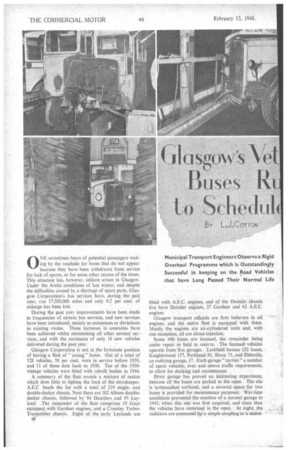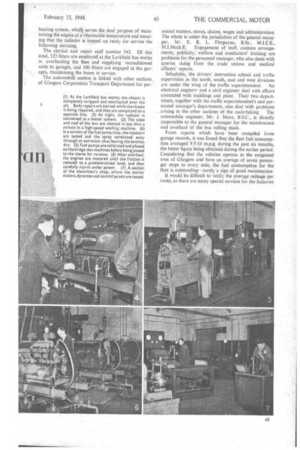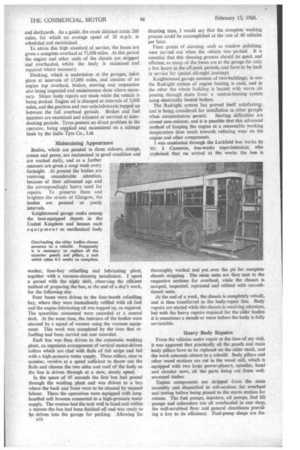0 NE sometimes hears of potential passengers waiting by the
Page 42

Page 43

Page 44

Page 47

If you've noticed an error in this article please click here to report it so we can fix it.
roadside for buses that do not appear because they have been withdrawn from service for lack of spares, or for some other reason of the times. This situation has, however, seldom arisen in Glasgow. Under the Arctic conditions of last winter, and despite • the difficulties caused by .a shortage of spare parts, Glasgow Corp.oration's bus services have; during the past year, run 17,500,000 miles and only 0.2 per cent. Of mileage has been lost. .
During the past year improvements have been made to frequencies of certain, bus services, and new services have been introduced, mainly as extensions or deviations to existing routes. These increases in amenities have been achieved whilst maintaining all other normal services, and with the assistance of only 16 new vehicles delivered during the past year. . .
. Glasgow. Corporation is not in the fortunate position of haying a .fleet of ." young" buses. Out of a total of 528 vehicles, 50 per cent. were in service before 1939, and 11 of these date back to 1930. Ten of the 1930vintage vehicles Were fitted with rebuilt bodies in 1944, A summary of the fleet reveals a mixture of makes which does little to lighten the load of the storekeeper. A.E.0 heads the list with a total ,of 219 singleand double-decker chassis. Next there are 102 Albion doubledecker chassis, followed by 94 Daimlers and 93. Leyland. -The remainder of the fleet comprises 19 Guys .eizinippedith Gardner-engines, and a Crossley. TurboTrans,naitter, chassis. •Eight of,the ::early Leylands are
fitted with A.E.C. engines, and of the Daimler chassis five have Daimler engines, 27 Gardner and 62 A.E.C.
engines • Glasgow transport officials are firm believers in oil engines, and the entire fleet is equipped with them. Mostly the engines are six-cylindered units and, with one exception, all are direct-injection. '
Some 490 buses are licensed, the remainder being under repair or held in reserve. The licensed vehicles operate from five garages. Larkfield houses 152 buses, Knightswood 157, Parkhead 91, Ibrox 73, and Elderslie, an outlying garage, 17. Each garage "'carries "a number of spare vehicles, over and, above. traffic requirements, to allow for docking and maintenance.
Ihrox garage has proved an interesting experiment, because all the buses are parked in the open. The site is tarmacadam -surfaced, and a covered -space for two buses is provided for maintenance purposes. War-time conditions prevented the erection•of a normal garage in 1943, when this site was first acquired, and since then the vehicles have rettkained in the open. At night, the radiators are connected ,13ya simple coupling to •a,steani• heating system, ‘ivhielt serves the dual purpose of maintaining the engine at a reasonable-temperature and ensuring that the radiator is topped up ready for service the
following morning. ' The clerical and repair staff number 943. Of this total, 123 fitters are employed at the Larkfield bus works in overhauling the fleet and supplying reconditioned units to garages, and 100 fitters'are engaged at the garages, maintaining the buses in service. The automobile section is linked with other sections of Glasgow Corporation Transport Department for per
sonnet matters, stores, claims, wages and administration: The whole is under the jurisdiction'of the general Manager, Mr. E. R. L. Fitzpayne, B.Sc., M.I.E.E., M.I.Mech.E. Engagement of staff, canteen arrangements, publicity; welfare and conductors' training are problems for the personnel manager, who also deals with queries rising from the trade unions and medical officers' reports.
Schedules, the drivers' instruction school and traffic supervision in the north, south, east and west divisions are under the wing of the traffic superintendent. An
electrical engineer and a civil engineer deal with affairs connected with buildings and plant. Their tWo departments, together with the traffic superintendent's and personnel manager's departments, also deal with problems arising in the other sections of the undertaking. The automobile engineer, Mr. J. More, .B.S.C., is directly responsible to the general manager for the maintenance and overhaul of the bus rolling stock.
From reports which have -been compiled from garage records, it was found that the fleet fuel consumption averaged 9.5-10 m.p.g. during the past six months, the better figure being obtained during the earlier period. Considering that the vehicles operate in the congested area of Glasgow and have an average of seven passenger stops to every mile, the, fuel consumption for the fleet is outstanding—surely a sign of good maintenance.
It would be difficult to verify' the average mileage PO route, as there are many special services for the factories and dockyards. As a guide, the route distance totals 260 miles, for which an average speed of 10 m.p.h. is scheduled and maintained.
To attain this high standard of service, the buses are given a complete overhaul at 75,000 miles. At this period the engine and other units of the chassis are stripped and overhauled, whilst the body is examined and repaired where necessary.
Docking, which is undertaken at the garages, takes place at intervals of 15,000 miles, and consists of an engine top overhaul, brakes, steering and suspension also being inspected and maintenance done where necessary. Minor body repairs are made while the vehicle is being docked. Engine oil is changed at intervals of 5,000 miles, and the gearbox and rear-axlelubricants topped up between the full overhaul periods. Brakes and fuel injectors are examined and adjusted or serviced at interdocking periods. Tyres present no direct problem to the operator, being supplied and maintained on a mileage basis by the India Tyre Co., Ltd.
Maintaining Appearance
Bodies, which are painted in three colours, orange, cream and green, are maintained in good condition and are washed daily, and as a further measure are given a soap wash every fortnight. At present the bodies are receiving considerable attention, because Of their advanced age and the correspondingly heavy need for repairs. To preserve them and brighten the streets of Glasgow, the bodies are painted at }early intervals, Knightswood garage ranks among the best-equipped depots in the United Kingdom and houses such equipment as mechanical body washer, four-bay refuelling and lubricating plant, together with a vacuum-cleaning installation. I spent a period with the night shift, observing the efficient method of preparing the bus, at the end of a day's work, for the following dav Four buses were driven to the four-booth refuelling bay, where they were immediately relined with oil fuel and the engine lubricating oil was topped up, as required. The quantities consumed were recorded at a central desk. At the same time, the interiors of the bodies were cleaned by a squad of women using the vacuum equipment This work was completed by the time that refuelling had been carried out and recorded.
Each bus was then driven to the automatic washing plant, an ingenious arrangement of vertical motor-driven rollers which are clad with flails of felt strips and fed with a high-pressure water supply. These rollers, nine in number, revolve at a speed sufficient to throw out the flails and cleanse the two sides and roof of the body as the bus is driven through at a slow, steady speed.
In the space of 45 seconds the first bus had passed through the washing plant and was driven to a bay where the back and front were to be cleaned by manual labour. There the operatives were equipped with longhandled soft brooms connected to a high-pressure water supply. The women had the task well in hand and within a minute the bus had been finished off and was ready to be driven into the garage for parking. Allowing for rit0 shunting time, I would say that the complete washing process could be accomplished at the rate of 40 vehicles per hour.
Finer points of cleaning, such as window polishing, were carried out when the vehicle was parked. It is essential that this cleaning process should be quick and efficient, as many of the buses are at the garage for only a few hours in the off-peak periods, and have to be back in service for special all-night journeys.
Knightswood garage consists of two buildings; in one the Radright system of engine heating is used, and in the other the whole building is heated with warm air passing through ducts from a central-heating system using electrically heated boilers.
The Radright system has proved itself satisfactory, and is being considered for installation in other garages when circumstances permit. Starting difficulties are almost non-existent, and it is possible that this advanced method of keeping the engine at a reasonable working temperature does much towards reducing wear on the engine and other components.
I was conducted through the Lark.field bus works by Mr. J. Cameron, bus-works superintendent, who explained that on arrival at the works the bus is
thoroughly washed and put over the pit for complete chassis stripping. The main units are then sent to the respective sections for overhaul, while the chassis is scraped, inspected, repainted and refitted with reconditioned units.
At the end of a week, the chassis is completely rebuilt, and is then transferred to the body-repair line. Body repairs are started while the chassis is receiving attention, but with the heavy repairs required for the older bodies it is sometimes a month or more before the body is fully serviceable.
Heavy Body Repairs
From the vehicles under repair at the time of my visit. it was apparent that practically all the panels and main body pillars have to be replaced on the older stock, and the work amounts almost to a rebuild. Body pillars and other wood sections are cut in the wood mill, which is equipped with two large power-planers, spindles, band and circular saws, all the parts being cut from wellseasoned timber.
Engine components are stripped from the main assembly and dispatched to sub-sections for overhaul and testing before being passed to the stores section for reissue. The fuel pumps, injectors, oil pumps, fuel lift pumps and exhausters are all overhauled in one shop, the well-scrubbed floor and general cleanliness providing a key to its efficiency. Fuel-pump shops are fre
quently poorly lighted and the floors sodden with oil, but that at Larkfield is a notable exception.
Normally the spray ejected from the injectors on test brings about this oil-sodden condition, but in the Larkfield shop the injectors spray into a duct which is connected to an extractor fan, and the entire mist is carried away, leaving the benches, tools and floors dry. Two Hartridge test machines are used to phase and calibrate the fuel pumps, to suit the requirements of the different types of engine. The exhausters and oil pumps are tested on rigs which have been manufactured in the workshops, and have to undergo a strict test before being passed to the stores.
The electricians' shop is as clean as the fuel-pump shop, and is well equipped to overhaul and test starter motors, dynamos and control panels.
The entire engine assembly is stripped and cleaned in a section apart from the main machine and repair shop, so that the floor space is not congested or covered with oil. After inspection, the component parts are reconditioned, the crankshaft being machined on one of the two grinders, the case refitted with new or reconditioned bearings, and machined on a Richards line borer.
Many components undergo some form of recondition ing, rebuilding by welding or Sifbronze representing the main method of repair. Shackle links are rebuilt by arc welding and refaced on a vertical grinder, the same machine being used to reface clutch plates and cylinder heads where necessary. Handbrake brackets, primaryshaft spigot lands and wormshafts are rebuilt by the Sifbronze method, and machined to the nominal size.
After reassembly the engine is passed to the test beds, where it is motored until the friction load falls to about 10-15 h.p., at which point it is put on a light load at 1,000 r.p.m., the load being gradually increased over a further four hours' running. The engine is finally tested for power and consumption, the results of which are set at a high standard, and, having passed these tests, it is stored on a rack for refitment to a chassis.
In this manner, seven to nine engines a week are overhauled, and because the standard of efficiency is high, they are expected to cover 75,000 miles between overhaul. Premature failures are subjected to a strict investigation to trace the cause.
Power-driven hand tools are in full use throughout the workshop, and a Broom and Wade 200-cubic-ft. compressor supplies air for all pneumatic equipment, including a sand-blasting plant.




















































































